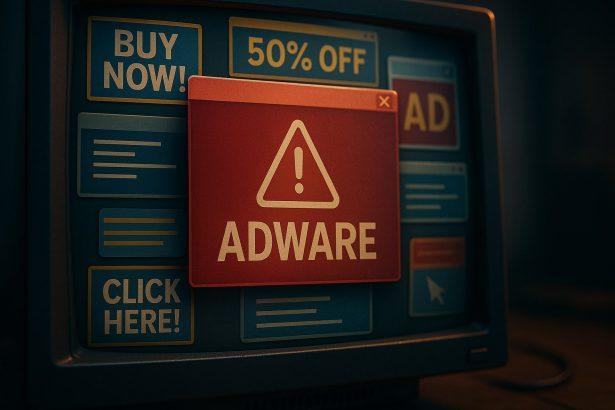HelperSection is a macOS adware belonging to the AdLoad family. It’s designed to display aggressive pop-ups, banners, and redirect your browsing to questionable sites—all to grab revenue through clicks. Often delivered via deceptive software bundles or fake Flash Player installers, it may also silently track your online activity.
Threat Overview
| Category | Details |
|---|---|
| Threat type | Adware, Mac malware, Mac virus (AdLoad family) |
| Associated domains | Not hijacking browser settings in tests, but poses tracking risk |
| Detection names | Avast (MacOS:AdAgent-L [Adw]), Combo Cleaner (Gen:Variant.Adware.MAC.Adload.16), ESET-NOD32, Kaspersky (Not-a-virus:HEUR:AdWare.OSX.Adload.j) |
| Symptoms | System slowdowns, constant pop-up ads, redirects to dubious sites |
| Damage & distribution | Ad tracking, privacy risk, possible identity theft; spread via deceptive installers, torrents, fake Flash installs |
| Danger level | Moderate to High — performance degradation and privacy compromise |
| Removal tool | SpyHunter – cybersecurity tool for Mac adware removal: SpyHunter Download |
In‑Depth Evaluation
How did it infect your Mac?
HelperSection usually sneaks in through bundled freeware installations or fake Flash Player downloaders. Often bundled with apps downloaded from untrusted sites or torrents.
What does it do?
Once installed, it overlays intrusive ads (banners, surveys, coupons) onto your browsing pages and desktop. Clicking these may expose you to scams or initiate further unwanted installs. Additionally, it can quietly collect browsing history, cookies, credentials, and even payment information for profit.
Should you be worried?
Yes. Even if it doesn’t encrypt your files, HelperSection poses real danger due to privacy violations, sluggish performance, and unexpected redirections to harmful websites. If left unchecked, it can lead to serious consequences like identity theft or secondary malware infections.
Removal Steps Summary
- Quit browsers and open Applications in Finder. Trash any suspicious PUA (e.g., MPlayerX, NicePlayer, HelperSection).
- Navigate to LaunchAgents and LaunchDaemons folders in both
/Library/and~/Library/, and delete any unfamiliar.plistfiles likeinstallmac.AppRemoval.plistormyppes.download.plist. - Remove rogue browser extensions in Safari, Chrome, and Firefox.
- Scan with SpyHunter and follow its prompts to thoroughly clean any residual components.
Post‑Removal Follow‑Up
- Reboot your Mac, clear browser caches and cookies.
- Verify that annoying ads and redirects have ceased.
- Install only trusted apps from official sources and always choose custom installation to avoid bundled extras.
Method 1: Manually Removing Adware from Your Mac
Step 1: Uninstall Suspicious Applications
- Open
Finderand navigate toApplications. - Carefully review the list and look for applications you don’t recognize or didn’t install.
- Drag any suspicious applications to the
Trash. - Empty the
Trashto ensure they’re permanently removed. - Open
System Preferences>Users & Groups>Login Items. - Remove any unknown startup programs by selecting them and clicking the
-button.
Step 2: Remove Unwanted Browser Extensions
Safari
- Open Safari and click
Safari>Preferences>Extensions. - Look for any extensions you don’t recognize and uninstall them.
- Go to
History> “Clear History” to remove traces of adware-related activity.
Google Chrome
- Click the three-dot menu in the top-right corner and select
Extensions. - Find any unfamiliar extensions and remove them.
- Reset Chrome by going to
Settings>Reset settings> “Restore settings to their original defaults.”
Mozilla Firefox
- Click the three-line menu and go to
Add-ons and themes. - Remove any unknown extensions.
- Reset Firefox via
Help>More troubleshooting information> “Refresh Firefox.”
Step 3: Delete Malicious Files and Folders
- Open
Finder, pressShift + Command + G, and enter the following locations:~/Library/Application Support/~/Library/LaunchAgents/~/Library/LaunchDaemons/~/Library/Preferences/
- Look for suspicious files and remove them.
Step 4: Clear Your DNS Cache
- Open
Terminal. - Type the following command and hit Enter:
- Enter your administrator password if prompted.
Step 5: Restart Your Mac
Restart your Mac to finalize the removal process.
Method 2: Automatically Remove Adware with SpyHunter for Mac
If you prefer a hassle-free solution, SpyHunter for Mac can detect and eliminate adware efficiently.
Step 1: Download SpyHunter
Click the link below to download SpyHunter for Mac: Download SpyHunter Here.
Step 2: Install and Set Up SpyHunter
- Open the downloaded
.dmgfile. - Drag SpyHunter into the
Applicationsfolder. - Launch SpyHunter and allow it to update its malware definitions.
Step 3: Run a Full System Scan
- Open SpyHunter.
- Click
Start Scan. - Wait for the scan to complete and review the detected threats.
- Click
Fix Threatsto remove any adware found on your system.
Step 4: Restart Your Mac
Once SpyHunter has completed the removal, restart your Mac to ensure all traces of adware are gone.
Conclusion
HelperSection adware may appear harmless, but it degrades performance, compromises privacy, and can lead to serious online risks. By following manual cleanup and using SpyHunter, you can restore both performance and peace of mind on your Mac.




